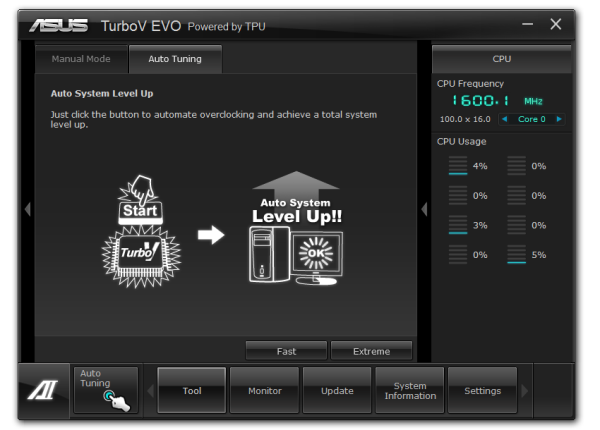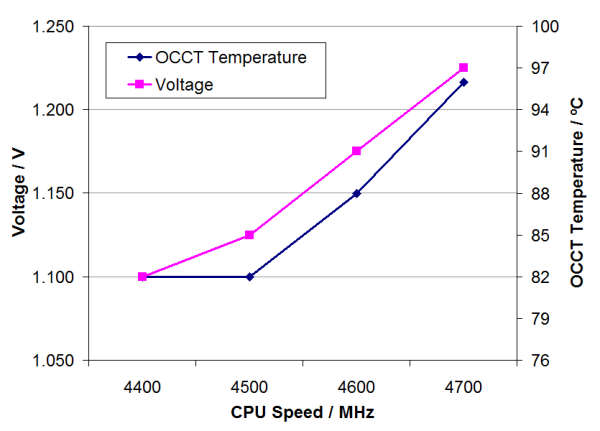ASUS P8Z77-V Premium Review: A Bentley Among Motherboards
by Ian Cutress on August 13, 2012 10:30 AM EST- Posted in
- Motherboards
- Asus
- Z77
ASUS P8Z77-V Premium Overclocking
Note: Ivy Bridge does not overclock like Sandy Bridge. For a detailed report on the effect of voltage on Ivy Bridge (and thus temperatures and power draw), please read Undervolting and Overclocking on Ivy Bridge.
Experience with ASUS P8Z77-V Premium
Overclocking with the P8Z77-V Premium was as straightforward as any other ASUS motherboard. In terms of automatic overclocking, we have two options in AI Suite – Fast and Extreme. The TPU switch and OC Tuner option in the BIOS both perform the ‘Fast’ option equivalent. The Extreme setting performs automatic stress testing in order to raise both the multiplier of the CPU and the BCLK to get the best overclock based on cooling and environment.
Manual overclocking was a little mixed - the way that ASUS performs the overclock is to apply the settings after the POST, which means that a user is almost always guaranteed to get into the BIOS. However, for the most part of our overclock testing, the system would go straight through into our testing, and would seem stable during the first couple of minutes in our testing before producing a memory error if the voltage is not sufficient. Nonetheless, we did get a competitive result for our overclocking.
One note I should point out – after seven weeks of dull and dreary weather here in the UK, during testing of this motherboard we ended up with bright sunshine, causing ambient temperatures to raise from 15°C to 25°C, and humidity to also rise. As a result, overclocking on this system hit its peak earlier than in other environments. Unfortunately it is not common for residential properties in the UK to have air conditioning either, so we had to make do with an additional pair of powerful Delta fans to aid cooling.
Methodology:
Our standard overclocking methodology is as follows. We select the automatic overclock options and test for stability with PovRay and OCCT to simulate high-end workloads. These stability tests aim to catch any immediate causes for memory or CPU errors.
For manual overclocks, based on the information gathered from previous testing, starts off at a nominal voltage and CPU multiplier, and the multiplier is increased until the stability tests are failed. The CPU voltage is increased gradually until the stability tests are passed, and the process repeated until the motherboard reduces the multiplier automatically (due to safety protocol) or the CPU temperature reaches a stupidly high level (100ºC+).
Our test bed is not in a case, which should push overclocks higher with fresher (cooler) air. We also are using Intel's All-in-one Liquid Cooler with its stock fan. This is a 120mm radiator liquid cooler, designed to mimic a medium-to-high end air cooler.
Automatic Overclock:
The two options for the automatic overclocking are found in AI Suite – either Fast, which applies a fixed overclock series of settings, or Extreme, which uses stress testing and sensors to find the best overclock with respect to the local environment. Here are our results.
At the Fast setting, the CPU was raised to the 41x multiplier and 103 MHz BCLK, giving an overall overclock to 4223 MHz. In the OS, this showed an OCCT load voltage of 1.128 volts, and peak temperatures during PovRay of 76°C and OCCT of 78°C.
At the Extreme setting, the CPU was raised to the 45x multiplier and 103 MHz BCLK, giving an overall overclock of 4635 MHz. In the OS, this showed an OCCT load voltage of 1.296 volts, and peak temperatures during PovRay of 98°C and OCCT of 102°C.
Manual Overclock:
Manual overclocks were performed purely by entering the BIOS and adjusting values. With the AI Overclock Tuner mode set to ‘Manual’, the main options being changed were the 1-core Ratio Limit and the CPU voltage set to a fixed value. Load Line Calibrations were left on Automatic. Here are our results.
Starting at the 44x multiplier and 1.100 volts set in the BIOS, the system showed an OCCT load voltage of 1.112 volts, and peak temperatures of 79°C during PovRay and 82° in OCCT were observed.
At the 45x multiplier, the minimum voltage stable was 1.125 volts set in the BIOS, which showed an OCCT load voltage of 1.128 volts. Peak temperatures of 80°C in PovRay and 82° in OCCT were observed.
At the 46x multiplier, the minimum voltage stable was 1.175 volts set in the BIOS, which showed an OCCT load voltage of 1.176 volts. Peak temperatures of 85°C in PovRay and 88° in OCCT were observed.
At the 47x multiplier, the minimum voltage stable was 1.225 volts set in the BIOS, which showed an OCCT load voltage of 1.232 volts. Peak temperatures of 93°C in PovRay and 96° in OCCT were observed.
At the 48x multiplier, a BIOS voltage of 1.275 volts was not stable in the OS, giving memory errors in PovRay and showing 98°C peak temperature during the initial PovRay running.












43 Comments
View All Comments
ptrinh1979 - Tuesday, August 14, 2012 - link
I was confused as well, but in my case, I can use this to offload the pagefile without sacrificing a drive bay in my chassis.BytesMage - Tuesday, September 11, 2012 - link
Page file is good for this. Planning on raiding 2 SSDs in raid 0 on Intel then SSD cache ll on the marvel with 2 60gb SSDs to 3tb HDD. I was wondering what to do with the 32gb mSata.ASUSTechMKT - Tuesday, August 14, 2012 - link
The 32GB mSATA was integrated to allow for quick access to utilizing Intel SSD Caching functionality. While many users are adopting high performance SSDs the cost of higher capacities is till high and in addition limited. Mechanical drives still considerably outpace and outsell SSDs in integration in all price points of desktops. Having this 32GB drive integrated easily allows for you to "SSD Cache a 2, 3 or 4TB drive" this allows you to have a much smoother and quicker response experience from the mechanical volume.While not noted the setup has also been streamlined in our utility to allow for a quick one click level of initialization for Intel SSD Caching or ASUS SSD Caching from the Marvell controller.
Rick83 - Monday, August 13, 2012 - link
At this price point, that is fairly ridiculous.So yes, there is "Thunderbolt", but a Firewire 800 Controller would probably be more useful, as there are way more Firewire devices in the wild than Thunderbolt.
Not sure how much the 82579V really can be called "server grade" either.
The 82579V on the Gene-Z shouldn't be all that different, having the same designation, but you have to manually hack the .inf to get the driver to install on Windows server. Not sure what makes this one server grade, seeing as the broken .inf comes directly from Intel.
Checking the other NIC, that one is more likely to be server grade, it costs almost twice as much. Not sure who made that mix-up.
IanCutress - Monday, August 13, 2012 - link
This was my error. The 82583 is not server grade, but as a helpful reader pointed out via email, the 82571, 82572, 82574, 82576, 82580 and I350 are. Super helpful naming scheme to tell them apart... :)Ian
Googer - Monday, August 13, 2012 - link
Thunderbolt is capable if mimicking firewire and just about every other IO technology in existence. So there is no real need for the added PCB Real Estate or monetary expense of a 1394 chip when 1394b is something that never really caught on (SAD).bigboxes - Tuesday, August 14, 2012 - link
Give up on the firewire. It's got USB 3.0. & USB 2.0. Anything you might need beyond that will either be Thunderbolt or some future USB 4.0. I've never needed Firewire. I've wasted money on a Firewire card, but that's not the same thing as needing it, now is it?Rick83 - Tuesday, August 14, 2012 - link
There's a lot of Firewire Video stuff (I'm following the IEEE1394-Linux mailing list, and there is still development and occasional use in a variety of contexts) Also I have a FireWire CF-reader. Not to mention that it's still much cheaper than TB, and in the shape of FW-800 still bloody fast, thanks to physical DMA.Also, at 450 euro, there's just no reason not to mark that check-box. Thunderbird is NOT a drop-in replacement. It's not like there's no space left on the back plane.
I actually had a look at the P8C WS yesterday evening, and it seems that that board is what this board should be, at half the price.
Two server grade NICs, FireWire, DVI out, support for ECC MEM and Xeons.
No WiFi, Thunderbolt, SSD or PLX though, but then those are probably less useful to (me and) most people, than the aforementioned.
Oh and it has 4x SATA less. But then 10x SATA is what my much cheaper GigaByte P55-UD5 has, and had years ago (Yes, they're all in use - Yes I'm looking at the WS because I've been having issues (kernel panics, NICs misbehaving) with it lately and server NICs and ECC probably are a good idea after all)
BoloMKXXVIII - Monday, August 13, 2012 - link
I have to agree with others who are a bit confused why a 32 GB SSD was included. As for the rest of the board, I will keep an eye out for when this board starts dropping in price. It is bound to happen. As long as it doesn't take too long it could fit well into my near future plans.Kristian Vättö - Monday, August 13, 2012 - link
Any idea how the Marvell 9230 SATA 6Gbps controller performs? Marvell's previous controllers haven't been too great, so I'm curious to know if the 9230 is any better.